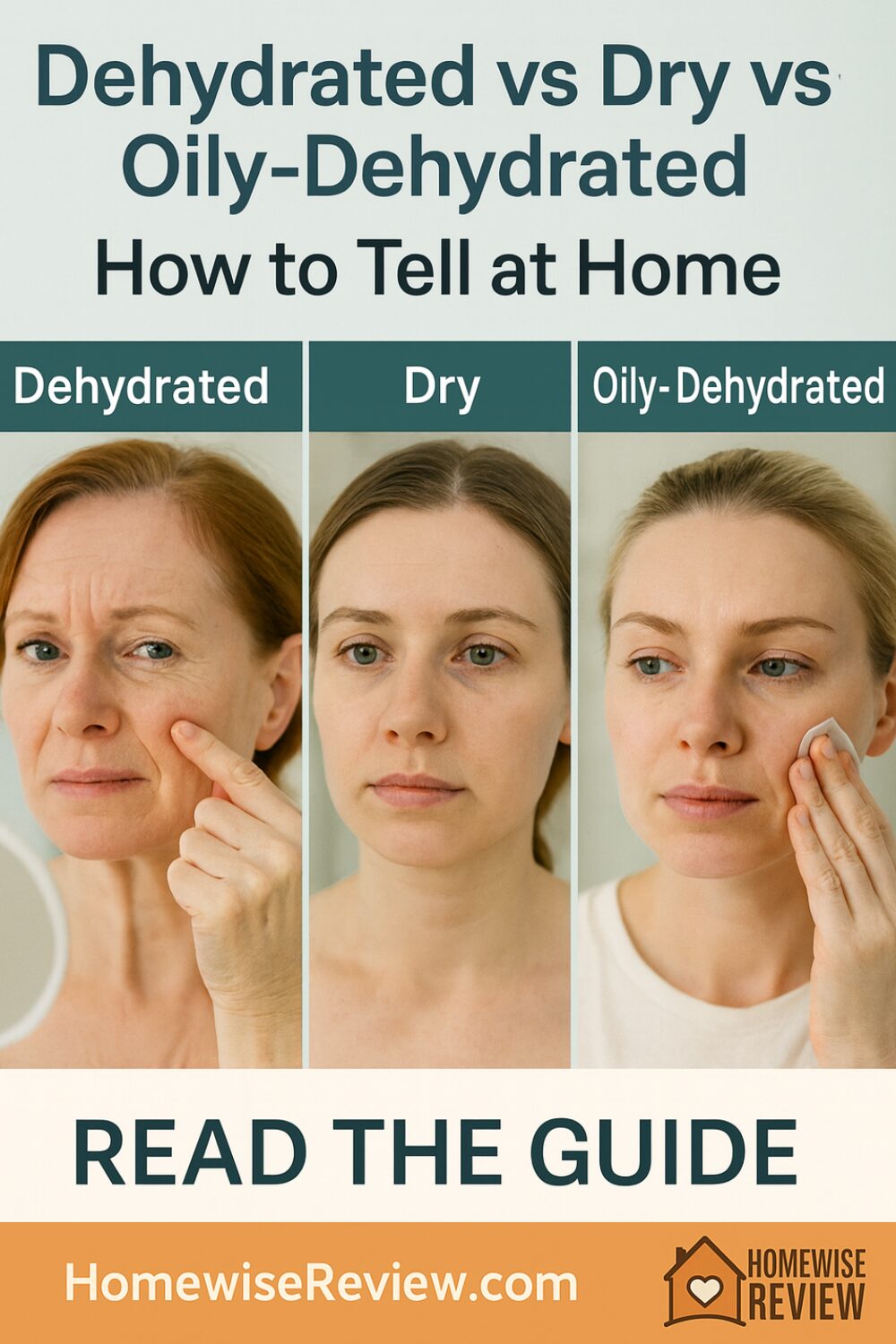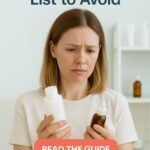
Shiny forehead but tight cheeks. Makeup cracks by noon yet your T-zone still looks slick. Or maybe your face feels rough and dull even after moisturizer. These are classic mixed signals. The fix starts with the right diagnosis at home. “Dry” is a lack of oil. “Dehydrated” is a lack of water. You can have both at once, including an oily surface with water-deprived skin underneath. This guide gives you simple tests you can run today, what results mean, and step-by-step routines that keep your barrier calm. You will also get a weekly map you can follow and clear triggers to avoid, so you spend less money guessing and more time seeing steady results.
What each one means in plain English
Dry skin produces less oil. It often looks matte all day, feels rough after cleansing, and shows fine, papery lines when you smile. Flakes can appear around the nose and brows. Products soak in fast and you rarely look shiny even in heat.
Dehydrated skin is low on water. Any skin type can be dehydrated, including oily. Signs include a tight feel after washing, sudden dullness, and fine “crinkle” lines that smooth out quickly after you apply a hydrating product. Makeup looks flat or powdery within hours.
Oily-dehydrated skin has an oil-rich surface and water-poor layers underneath. The top looks shiny within two to four hours of cleansing. The skin can still feel tight or thirsty, and you may see small closed bumps with a dull cast. You blot often, yet makeup still separates around the nose and chin.
The key difference is fuel. Dry skin needs lipids to slow water loss. Dehydrated skin needs water plus humectants to pull and hold that water. Oily-dehydrated needs a calm cleansing routine, water-based hydration, and lightweight barriers that do not clog.
Five quick at-home tests
Run these on a calm day with your usual cleanser. Keep notes.
1) Wash-and-wait test (20 minutes)
Cleanse gently, pat dry, and apply nothing. Wait 20 minutes.
- Feels tight and looks dull across the whole face: dehydration is likely.
- Tight only on cheeks or jaw while T-zone feels fine: combination or oily-dehydrated.
- No tightness but rough patches remain: dryness is dominant.
2) Blot test (midday)
Press a plain tissue or blot sheet on the forehead and nose at midday.
- Little to no oil transfer and the skin still feels rough: dry.
- Noticeable oil transfer with a tight feel earlier in the morning: oily-dehydrated.
- Some oil on T-zone, none on cheeks, plus dullness overall: dehydrated combination.
3) Pinch test (cheek and under-eye)
Gently pinch a small area for two seconds and release.
- Fine, crinkly lines appear and then fade in a few seconds: dehydration.
- No crinkle lines but lingering redness or rough texture: dryness.
4) Foundation wear check (4 hours)
Apply your usual base. Check at hour four.
- Base looks chalky or powdery even with a dewy product: dehydration.
- Base separates around nose and chin while cheeks look flat: oily-dehydrated.
- Base looks fine but flakes are visible around nostrils and brows: dry.
5) Shine timeline
Note when shine appears after morning cleanse.
- Under 2 hours: oil-forward, likely oily or oily-dehydrated.
- 3 to 5 hours: combination or balanced.
- 6 plus hours with no shine at all and frequent tightness: dry or dehydrated leaning dry.
Use at least three tests. If two or more point the same way, you have your working diagnosis.
Common triggers by type
Dry skin triggers
Over-cleansing, very hot water, low-lipid routines, alcohol-heavy toners, and skipping moisturizer. Dry climates and constant indoor heat make it worse. Fragrance around the nose and cheeks can add sting.
Dehydrated skin triggers
Not enough water-binding steps, harsh surfactants, too many actives in one pass, and long, hot showers. Air travel, heaters, and high winds speed water loss. Strong acids stacked with retinoids raise the risk.
Oily-dehydrated triggers
Stripping cleansers, frequent clay masks, and skipping lightweight hydration. Skin responds by overproducing oil while staying thirsty underneath. Heavy occlusives at the wrong time can trap heat and lead to congestion.
Fixes by type: step-by-step routines
Pick the lane that matches your tests. Build for four to six weeks before you judge results.
Dry skin routine
AM:
- Creamy or gel-cream cleanser, 20 seconds.
- Hydrating serum with glycerin or hyaluronic acid.
- Mid-weight moisturizer rich in ceramides or cholesterol.
- Broad-spectrum SPF 30 plus.
PM: - Gentle cleanse.
- Optional low-strength lactic acid once weekly if texture is rough.
- Nourishing moisturizer or a few drops of squalane over moisturizer.
Cadence tips: Keep acids light and rare. If you use a retinoid, buffer with moisturizer first and start twice weekly.
Dehydrated routine
AM:
- Rinse or very mild cleanse.
- Hydrating toner or essence. Press, do not rub.
- Humectant serum with glycerin, panthenol, or HA.
- Light lotion moisturizer.
- SPF 30 plus.
PM: - Gentle cleanse.
- One active per night only. Rotate BHA or AHA two nights weekly if you are clogged, or a retinoid two to three nights if texture is your goal.
- Gel-cream moisturizer.
Cadence tips: Add a short contact hydrating mask 1 to 2 times per week. Watch for pilling. If you see it, shorten layers and increase wait times to 60–90 seconds.
Oily-dehydrated routine
AM:
- Gentle gel cleanser.
- Niacinamide 2 to 5 percent or a light hydrating serum.
- Oil-free gel-cream or emulsion.
- SPF 30 plus.
PM: - Gentle cleanse.
- BHA 0.5 to 1 percent two to three nights weekly for clogs.
- Retinoid two nights weekly on non-BHA days if texture needs help.
- Lightweight moisturizer.
Cadence tips: Keep clay masks to once per week. If cheeks feel tight, add a hydrating toner before moisturizer at night. If shine floods back under two hours, check if your cleanser is still too harsh.
A simple weekly map to stay balanced
Use one driver active per night. Keep rest nights. Adjust by season.
Mon: Hydrating routine only, no actives
Tue: BHA night if clogged, otherwise moisturizer-only night
Wed: Retinoid night or lactic acid if you cannot use retinoids
Thu: Rest night with richer moisturizer if dry spots persist
Fri: Light AHA night for dullness, or hydrating mask if dehydrated
Sat: Retinoid night or niacinamide plus moisturizer if sensitive
Sun: Rest night
Morning stays steady all week with hydration plus SPF. This rhythm reduces guesswork and prevents ingredient clashes.
When to adjust or seek help
Adjust if you see new stinging from water alone, persistent redness that lasts past the morning, or sudden rough patches after you added a product. Drop back to a simple cleanse, hydrate, moisturize, SPF routine for five to seven days. If you have painful cystic acne, spreading rash, or peeling that will not stop, pause actives and speak to a professional for tailored care.
Final Thoughts
You do not have to overhaul your shelf. Identify the main issue, match the fix to oil or water needs, and keep one driver active per night. Most people feel a calmer baseline within two to four weeks when they stop stacking actives and start feeding the barrier with the right mix of water and lipids. Once you reach that steady point, adjust cadence by one step at a time. Small changes beat big swings.
See also
If shine and clogged look are your main headache, start with Pore Care Without Wrecking Barrier for a gentle plan that clears without stripping. To avoid common mix-ups that stall progress, Ingredient Clash List to Avoid shows which pairs to separate and how to pace them so each product can work.
If your cleanser and actives still feel like they fight each other, Skin pH Basics: Why It Matters and How to Keep Balance helps you pick the right cleanser and schedule. Need hydration that plays well with makeup, try the picks in Best Hydrating Toners for Dry Skin. If your skin is lipid-hungry and rough even after toner, Best Moisturizer for Dry Skin rounds out a routine that actually lasts through the day.
FAQs
1) Can I be oily and dehydrated at the same time
Yes. Your oil glands can be active while your skin still lacks water. Fix with gentle cleansing, a hydrating serum, and a lightweight moisturizer. Keep BHA and retinoids on separate nights.
2) How long until I see results after changing routines
Many people feel less tightness in one week. Texture and shine balance usually improve within two to four weeks if you stop stacking actives and keep hydration steady.
3) Do I need both a hydrating toner and a serum
Not always. If you hate layers, pick one hydrating step and use a little more of it. If you love layers, keep them thin and wait 60 to 90 seconds between steps to avoid pilling.
4) My makeup still looks cakey at noon. What should I change first
Hydrate under makeup with a thin humectant serum, then a light lotion. Let SPF set for a minute before foundation. If you still cake, reduce powder and use a blot sheet midday.
5) How often should I exfoliate if I am dehydrated
Start with once weekly. If your skin stays calm, move to twice weekly. Keep acids on their own night and add a rest night after any sign of sting or new flakes.
Affiliate Disclosure
If you purchase through links on our site, we may earn a small commission at no extra cost to you.




